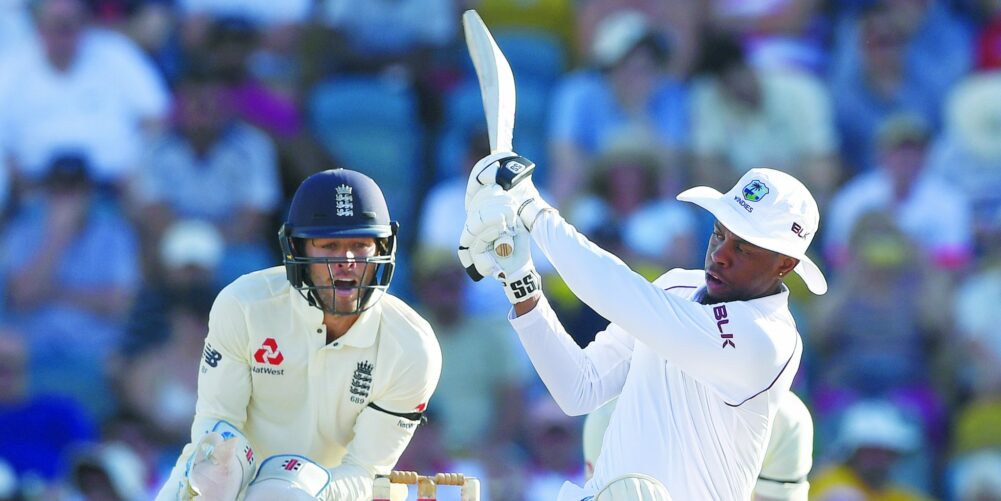In the build-up to England’s current tour of the West Indies, former England captain Graham Gooch was interviewed about the experience of being on the wrong end of the fastest century in Test cricket.
Sir Viv Richards’ knock of 103 off 56 balls in 1986 was a sight to behold. As the spectacle unfolded the balls rained down on the adjacent prison where its inmates stood, gleefully “rattling their cups and saucers” as the felt-capped Sir Viv unleashed against England’s hapless bowlers.
It is a happy memory for any West Indian cricket fan and one that was aroused as Shimron Hetmyer, white floppy hat propped nonchalantly upon his forehead, pummelled sixes in similar fashion. So, too, as Kemar Roach ripped through England’s batting and Jason Holder, tall, powerful, and with a touch of arrogance of old, stroked a double century against an England attack that had simply run out of options.
Nostalgia was well and truly stirred.
It is a nostalgia firmly underpinned by classical, quick and uninhibited fast bowling. How could we not think back to Walsh, Curtly, Holding, Roberts and Co. as Roach’s 5-17 from 11 overs plumped him firmly into the top ten West Indian wicket-takers of all time? He is, without doubt, sitting among legends.
Pre-series, however, the chatter was around how the Caribbean islands are no longer how they once were. “Sad today when, having ticked ‘sport’ on my immigration form, the officer asked me ‘which sport?’” lamented BBC cricket correspondent Jonathan Agnew. “There was only one sport here and what a role cricket played. His question said it all.”
Geoffrey Boycott insisted on comparing the current team to the undefeated might of the Eighties. However, by these standards any team, of any nation, are surely consigned to “ordinary, average cricketers”.
It is tempting, comforting and, for a brief moment, hugely enjoyable therefore to raise the possibility that maybe, just maybe, the current crop can emulate those greats. And yet, just like a night on the tiles – where the balance tilts just over the precipice from the pleasantly sloshed into the over-indulged, ill-advised-actions territory – the hangover can be severe, enduring and hugely damaging.
Following the Brexit vote two years ago, the late AA Gill wrote of the will to take back control as akin to “snorting a line of the most pernicious and debilitating Little English drug, nostalgia. The warm, crumbly, honey-coloured, collective ‘yesterday’ with its fond belief that everything was better back then … at some foggy point in the past…”
Apply it to cricket and we might equally question whether our past judgment is quite as clear as we wish it to be?
This is not to say that the undefeated decade of the Eighties was an era that never existed, yet it was finite and disguises much of the struggle that went before. In 1976, the term ‘Calypso cricketer’ was a stigma that had long burdened the West Indies team, describing a band of entertainers, capable of flashes of brilliance but unable to persevere, as professionals, to a match’s conclusion.
The evolution of the Mighty West Indies was a process. This current team is similarly transitioning, trying to find its own identity. This was echoed in Jason Holder’s pre-series interview, where he was hesitant, ambivalent about the type of pitch his team wanted prepared.
On the one hand, he acknowledged that a fast, shiny deck might entice the crowds to the prospect of the swashbuckling, searingly quick West Indies of old. On the other, his team needed to win.
“I remember talking to my old man,” reminisced Mark Butcher in an interview with ESPN’s Switch Hit podcast. “Everyone leaping around and batters getting their helmets knocked off. He said it was absolutely brilliant, compelling to watch. One of the most visceral experiences of touring in the Caribbean was not only the fact that they are trying to kill you on the field, Curtly and Co, on fast, bouncy and sometimes up-and-down pitches, but the way that that translated into the support.
“It has just become less exciting for them, less macho if you like,” explained Butcher of the current side. “Because that’s Caribbean cricket isn’t it? Quick bowlers.”
Yet there is a danger of bowing to stereotypes. It was something, Graham Onions suggested on the BBC’s Cricket Social, that Sri Lanka for example had already fallen prey to. So eager are they to find the next Muralitharan, or Herath, they have parachuted inexperienced spinners onto turning pitches. Instead of allowing them to develop, they succumb to expectation. Contrast to India, who have happily shed their reputation of being unable to bowl fast, while Pakistan through Yasir Shah is striving to depart from its fast-bowling assumption.
Ultimately, Holder opted for a pitch with variable bounce and of unpredictable nature. It might not be conducive to unadulterated pace, but it provided his inconsistent batting side with an opportunity to compile an innings in the first place. The enthusiasm and support surrounding the women’s T20 World Cup, where the West Indies performed admirably, showed no harking for the past. The women, after all, didn’t compete in a World Cup until 1988. They are now, however, winning.
“A traditional burst of West Indian fast bowling at its best,” wrote one broadsheet columnist of Roach’s spell. Only it wasn’t. Roach bowled brilliantly, but he is not careering in at 90mph. Nor was Holder. The match’s best bowling was comprised of seam, skill and control: Anderson, Holder, Roach. Hetmyer, too, floppy hat aside, is born of a different generation, from a new, exciting format of the game. Let the West Indies carve their own future and not patronise them about the past.
ISABELLE WESTBURY / Photo: Getty Images















